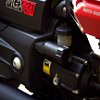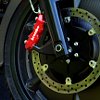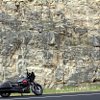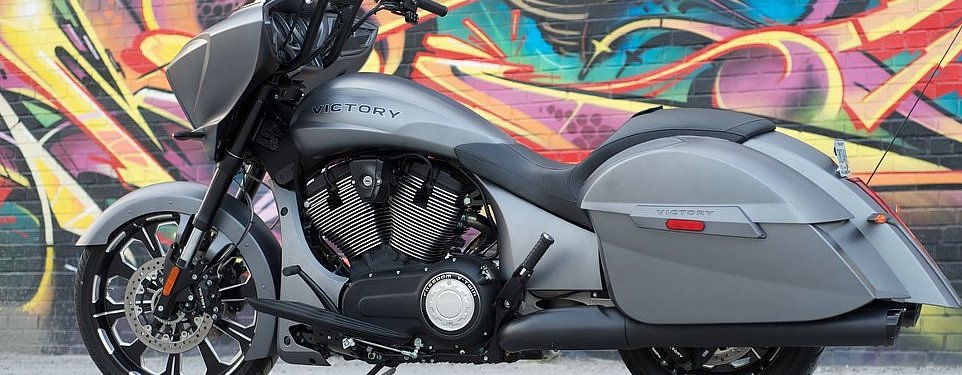I’ve long felt that the incumbent manufacturers of full-dress touring machines have been domestic due largely to the fact that employees of those companies ride motorcycles in America. Put plainly, they understand the geography of this land.
Understanding the topography is difficult if one has not physically ground out lots of miles across the United States. Lately, the bagger has been a mainstay of motorcycling in America, but has not gained massive amounts of traction in other markets. Think about it: We’ve got a huge landmass here, with (relatively) excellent infrastructure, and generally speaking, we are a rich enough population to purchase large, opulent bikes that make covering ground less taxing.

Moto Guzzi, it appears, has done some homework before trying their hand at dethroning the reigning powers. This past week I was in Deadwood, South Dakota, just a stone’s throw away from Sturgis, for the first-ever American release of a Guzzi motorcycle, the MGX-21 Flying Fortress. (Moto Guzzi Experimental. The “21” refers to both the front wheel size and the year the first Goose rolled out of the factory.) I had a very condensed first ride of about 300 miles, in which I got acquainted with the machine. I got some definite impressions of the bike, and while I was not able to perform a full RevZilla torture test, I think I can synthesize some key points about the bike and help anchor it relative to some of the more established touring bikes on the market.

I scored a Guzzi that was not quite stock: My test unit was outfitted with optional Guzzi mufflers. The 90-degree Guzzi mill, while foreign-sounding to my 45-degree-V-loving ears, emitted a tune that any seasoned motorcyclist should be able to appreciate. Metric V-twins that fall between those two have all the appeal of an air compressor to me. Happily, no one will mistake the MGX-21 for anything other than an Italian, just based on its voice. The bike was also equipped with a carbon-fiber cowl replacing the pillion seat, the only other option that deviated from box-stock. (Personally, I’d skip that piece. I like taking Mrs. Lemmy with me.)

I thumbed the starter, and the bike came to life. Immediately, I noticed two things. First, the kill switch is a very strange type: It’s a latching switch. Second, this bike wears its weight way up high. Even pulling it off the stand, its weight (752 pounds, without fuel) is apparent. I don’t mean that as a knock: Touring sleds should be heavy. The heft that makes a full-size tourer a bear to wrestle or push around a garage is the same heft that stabilizes the bike at speed.

The bike was purring along nicely, and I took a few moments to familiarize myself with some of the electronic gizmos before getting underway. There’s available Bluetooth connectivity, but I have a dumb phone, so I just tried out the radio a few times. (It’s just OK. Totally not loud enough, but I have that same complaint on every bike with a radio. Honestly, if you want to listen to music on a bike, you’re better off with a comm headset, I think.)
I also played with the throttle modes. There’s Veloce (“fast”), Turismo (“touring”), and Pioggia (“rain”), if my notes and translation are correct. I like snappy throttles; Veloce made me happiest. I turned traction control to its least intrusive setting. Later in the day, I tested this on some gravel. The cutting in and out was so abrupt that I actually felt less safe with traction control turned on. The experience was reminiscent of a rookie whiskey-throttling: It made the whole bike seem like it was shuddering. The power would come back on so fast the cycle just seemed to repeat itself, and the softly sprung front end bucking up and down just magnified the issue. (More on that front end later.) The traction control system needs some work, in my estimation.
Selecting all these options did take me a few moments. They may not work the way you expect them to, but they’re not hard to figure out. Mostly, the Moto Guzzi is just different. For example, to set the cruise control, you hold the appropriate button and the light begins blinking. Once you’ve arrived at the speed you want to hold, you tap the button again, and the light goes solid. It’s not the “standard” turn-it-on-and-hold-set method, but it works just as simply.

At this point, I was almost done. I adjusted the levers. (!) That’s right, both the clutch and brake levers are adjustable. Fantastic! My excitement about this was dampened just a bit, though, when I realized the hydraulic clutch’s engagement point was very close to the handlebar. I couldn’t get the lever close enough to get the clutch disc to release reliably. Still, adjustable levers. That’s a nice touch. I also firmed up the rear suspension. It’s adjustable for preload and the remote adjuster means no tools are necessary. The remote adjuster tucks in nicely next to the starter.
Finally, after all this fiddlin’, I started moving. The bike composed itself very nicely as we moved through Sturgis and out onto some open two-laners. The engine was rocking away in the chassis, but very little of the vibration made it to my hands and ass. The Guzzi team did a good job isolating the big engine's shakin'. The throttle response in Veloce mode was crisp. It was immediately evident that the engine was very peppy, but this is not the standard huge-stroke-low-stress cruiser lump. If a rider wrings out the bike, it will bark and snarl and generally get up and move in a hurry. It reminded me in some ways of the Indian Scout I reviewed when it debuted. There is grunt to be found, but you need to work the throttle and the gearbox to get at it. It’s not how I like my power delivered on this class of motorcycle, but let’s be realistic: I’m probably not the target demographic here.
From 5,500 rpm right up to the 7,500 rpm redline, the Flyin’ Fortress was a whole bunch of fun. At 84 cubic inches, though, it is significantly smaller than the 100-plus cubic inches almost all of its competition boasts. Here's the thing: It makes power, it just makes it in a different spot than you'd expect a traditional bagger to make it. It's not right or wrong, it's just different. Giving it to you straight, it's not my cup of tea. If I'm on a barge, I like low-end grunt, like an Indian or Harley Big Twin delivers. But this bike's not aimed at the traditionalist, now, is it?
Shifting was as expected. The six-speed handled its duties without fanfare. Here's a data point for comparison. For those of you who have ridden a six-speed Harley dresser, you know how you feel like you’re gonna be shifting into overdrive gear at 80 mph or so? That’s not the case on the Guzzi. You’ll use sixth gear at 60 mph if you’re letting the bike be lazy, and if the goal is to actually motor through a section, you’ll likely leave it a gear or two lower to keep the engine where the power is.

The seating position was something I started paying attention to, as well. My upper half was comfortably upright. The fairing on this bike is not like a Harley batwing. It’s much smaller, and though it offers good head-and-chest wind protection, the tiny tips of the wings don’t cover the hands much at all. I bet this bike is unpleasant on the mittens in cold weather.

My bottom half felt good, too. The controls are sort of a split between a mid and a forward. Oddly, the MGX-21 uses footpegs for both rider and passenger. Call me dotty, but I expect floorboards for at least the rider on an American-styled touring bike. Another weird item was the passenger peg retraction. Rather than pivot up or up-and-back, they roll straight back. I like to use the p-pegs to change position on long-haul bikes like this, but they kept folding up on me when I tried to use them like some sort of weirdo secondary rearset.
As I got more comfortable on the bike, I started really tossing it into the turns. This section is probably the one with the most to report on — some good, some not. First up, let’s talk tires. The Goose came from the factory wearing a set of Dunlop Elite 3s. The Flying Fortress is not an inexpensive bike at $21,995, so it was nice to see real rubber on the bike. Oddly, they are both radials, even the front (120/70R21). The rear (180/60R16) seems a bit wide for a tire that’s not particularly visible, but it worked fine.

Handling was a bit of a mixed bag for me. I adjusted quickly to the Flying Fortress, but it’s a little odd. First, the 21-inch wheel up front makes the bike dip into a turn suuuuper quickly, maybe even too quickly. I thought the bike felt “nervous” at first, but I warmed up to it as the miles stacked up. Additionally, I’m not sure if it’s the carbon-fiber lenticular wheel covers, the batwing, or a combination of the two, but the bike did not make me feel confident when I caught crosswinds out there on the open plains of South Dakota.
The jury is still out on this one. I really think I’d need to do a more robust review to give a confident assessment of the handling. I’d also like to try one of these with the steering damper removed. I’d be curious to see if that is masking some geometry problem.
The suspension was adequate, but the front was noticeably undersprung. Ol’ Lem-lem rings in at around 275 these days, but a touring machine would easily be asked to handle that amount of pillion, gear, and rider. If it felt bouncy to me solo, it will probably feel that way to others going two-up. Happily, though, the lean angle on this bike is pretty impressive. Even with the suspension fully compressed, the MGX-21 maintains a 37-degree lean angle! I got this thing right down into some hairpins, and I did not scrape a thing. This was easily my favorite part of the bike. And how many of you have ever backed up your dresser to a curb, only to feel yourself scrape the snot out of your mufflers? Not a concern here. Parts are tucked up nice and high on the Flying Fortress. Kudos, design team.

Braking was sublime. Brembo four-pots up front grip stainless floating rotors, and out back you’ll find a two-pot Brembo. Lines are braided stainless. The brakes worked really well, the feel was fantastic, and hey, they’re red. I have no complaints whatsoever in the braking department.
The styling is noticeable, for sure. It’s not a copycat. Everything you see that looks like carbon fiber is carbon fiber. No cheesy appliqués here. The massiveness of the jugs swelling out from under the fuel tank really can’t be captured well in a photograph. You gotta see ‘em to believe ‘em. For my taste, the batwing looked a bit modern with the pointed tips and cleft in the center; it didn’t seem to blend in exactly with the rest of the bike, which I felt had a much more classic design. The bags, though beautifully swoopy, are unbelievably narrow and not really shaped conventionally.

Another area that was surprisingly devoid of ornamentation was the triple tree. It was great for us because we could easily mount action cameras, but it was a large expanse of very plain-looking open space. Still, I’m probably being picky; most people who saw the bike fell head-over-heels with the styling.

The price isn’t out to lunch at $21,995; it’s right in line with other bikes like the Harley-Davidson Street Glide, Indian Chieftain, or Victory Cross Country. Still, that’s a hefty sum of money, so the bike had damn well better deliver for the rider who selects it. I doubt Guzzi is gunning for the current Street Glide owner. Instead, I have this feeling they want someone who is interested in a bike that’s exclusive almost to the point of weirdness. I also think they’re shooting for the younger set; the rider coming off a truly fast bike who’s not totally ready to trade in leathers for a leather vest. In that sense, Guzzi has definitely found a hole in the market that the Flying Fortress can fill.
The MGX-21 was impressive. I didn’t expect something so competent from Moto Guzzi on their first crack. The engineering and research they performed absolutely shines through in the finished product. Putting something that was damn close to their initial concept bike onto the market was gutsy and bold, much like the bike itself. Is it worth the asking price? The market will tell us that shortly, I am sure. Is it for me? Definitely not. But I’ll nod my head knowingly at a rider on one of these bikes, because they clearly know what it means to ride in America.













